Mattel Bundle
Can Mattel Maintain Its Momentum in the Dynamic Toy Industry?
Mattel, a global leader in the toy industry, has consistently demonstrated the importance of a robust growth strategy. The remarkable resurgence of the Barbie brand, fueled by the 2023 'Barbie' movie, highlights Mattel's ability to reinvent itself and capitalize on entertainment integration. Founded in 1945, Mattel has evolved from a garage startup into a powerhouse with iconic brands like Hot Wheels and Fisher-Price.
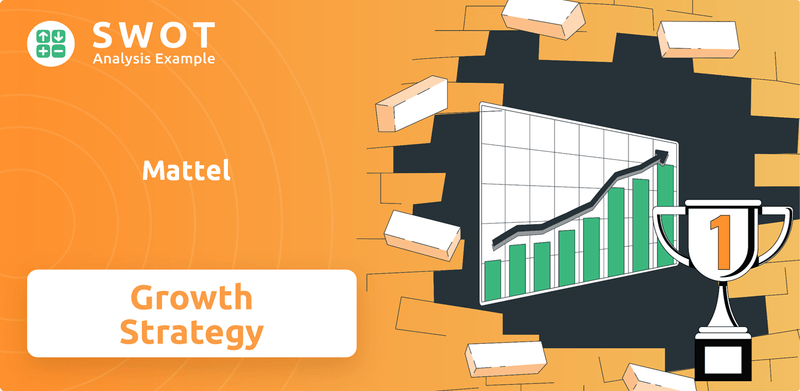
This Mattel SWOT Analysis will explore how Mattel navigates the ever-changing toy industry trends and plans for future growth. We'll examine Mattel's market share, financial performance, and strategic initiatives, providing insights into its competitive landscape and long-term goals. Understanding Mattel's growth strategy is crucial for anyone interested in the company analysis and its future prospects, including its expansion into new markets and adaptation to digital trends.
How Is Mattel Expanding Its Reach?
To ensure future growth, the company is actively implementing a multi-faceted expansion strategy. This strategy focuses on several key areas, including entering new markets and expanding its product offerings. The company's approach involves a blend of organic growth and strategic partnerships.
A crucial element of the expansion strategy is to increase its presence in emerging markets. These markets, particularly in regions such as Latin America and Asia, provide significant opportunities for increased toy consumption due to a growing middle class. This focus aligns with broader toy industry trends, which highlight the importance of adapting to global consumer preferences.
The company's strategy also includes venturing beyond traditional toys. It is expanding into areas like digital gaming, animation, and consumer products. This diversification is designed to engage with a new generation of consumers and diversify revenue streams, which is a key aspect of the company's long-term goals.
The company is prioritizing growth in emerging markets, especially in Latin America and Asia. These regions have a rising middle class, which increases the demand for toys. This expansion is part of the overall Marketing Strategy of Mattel to reach a wider audience.
The company is expanding its product categories beyond traditional toys. This includes ventures into digital gaming and animation to diversify revenue streams. This strategy helps in adapting to digital trends and meeting the changing preferences of consumers.
The company continues to seek licensing agreements and co-branding opportunities. This strategy helps broaden its reach and appeal to diverse audiences. These collaborations are crucial for staying ahead of rapidly changing industry trends and maintaining a strong market share.
The company is focused on innovation in toy design and adapting to digital trends. This includes creating digital games based on its intellectual property. These initiatives are designed to access new customer segments and bolster brand relevance.
The company’s expansion initiatives are designed to drive future growth. These initiatives include entering emerging markets, diversifying product categories, and forming strategic partnerships. These moves are part of the company's response to the competitive landscape analysis and its long-term goals.
- Expansion into emerging markets, focusing on Latin America and Asia.
- Diversification into digital gaming, animation, and consumer products.
- Strategic partnerships and collaborations to broaden reach and appeal.
- Focus on innovation in toy design and adaptation to digital trends.
Mattel SWOT Analysis
- Complete SWOT Breakdown
- Fully Customizable
- Editable in Excel & Word
- Professional Formatting
- Investor-Ready Format
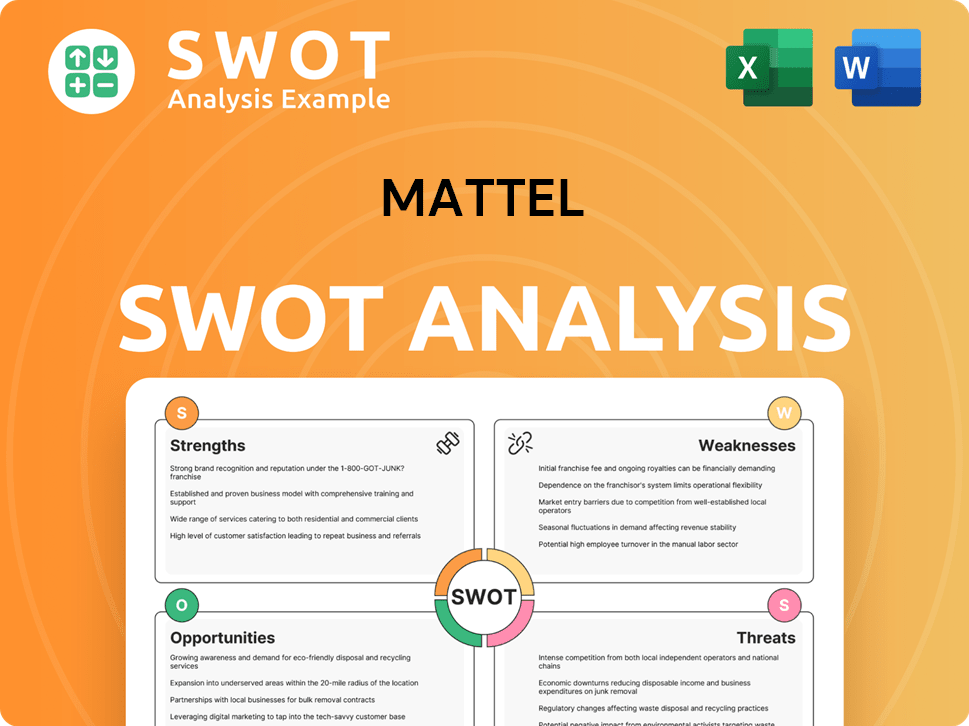
How Does Mattel Invest in Innovation?
The company is actively employing innovation and technology to drive its Mattel growth strategy and maintain a competitive edge in the toy industry. This involves substantial investments in research and development, fostering both internal creativity and external collaborations to bring innovative products to market. The integration of digital technologies and sustainable practices is central to these efforts.
Mattel's approach to digital transformation includes developing interactive toys, app-integrated play experiences, and direct-to-consumer e-commerce platforms. Augmented reality (AR) is integrated into certain toy lines to enhance play value and provide new avenues for engagement. Furthermore, the company is exploring the application of AI in product development and personalization, aiming to create more tailored and engaging experiences for children.
Sustainability is a key component of Mattel's innovation strategy. The company focuses on developing eco-friendly materials and packaging, demonstrated by initiatives like the 'PlayBack' recycling program and the introduction of more sustainable toy lines. These technological advancements and sustainable practices directly contribute to growth objectives by creating new product categories, enhancing brand appeal, and meeting evolving consumer demands.
Mattel is actively integrating digital technologies to enhance play experiences. This includes interactive toys, app-integrated play, and direct-to-consumer e-commerce platforms. These initiatives aim to meet evolving consumer demands and create new avenues for engagement.
AR is being integrated into toy lines to boost play value and engagement. This technology offers interactive experiences that enhance the appeal of Mattel's products. This strategy aligns with the company's goal of staying at the forefront of technological innovation.
The company is exploring the use of AI in product development and personalization. The goal is to create more tailored and engaging experiences for children. This approach aims to create more engaging and personalized experiences.
Mattel is committed to sustainability, focusing on eco-friendly materials and packaging. The 'PlayBack' recycling program and the introduction of more sustainable toy lines highlight this commitment. These initiatives are crucial for meeting consumer expectations and supporting long-term growth.
The company is actively developing toys using sustainable materials. This includes exploring alternatives to traditional plastics and reducing the environmental impact of its products. This focus on sustainability is a key part of Mattel's innovation strategy.
The 'PlayBack' program allows consumers to recycle used toys, contributing to a circular economy. This initiative supports Mattel's sustainability goals and enhances its brand image. This program underscores the company's commitment to environmental responsibility.
Mattel's innovation strategy focuses on integrating technology and sustainability to drive growth and meet evolving consumer needs. This includes digital enhancements, AI applications, and eco-friendly practices.
- Digital Integration: Enhancing play experiences through interactive toys and app integration.
- AI Application: Using AI for product development and personalization.
- Sustainability: Developing eco-friendly materials and recycling programs like 'PlayBack'.
- Market Adaptation: Adapting to toy industry trends and consumer preferences.
- Competitive Edge: Maintaining a competitive edge through continuous innovation.
Mattel PESTLE Analysis
- Covers All 6 PESTLE Categories
- No Research Needed – Save Hours of Work
- Built by Experts, Trusted by Consultants
- Instant Download, Ready to Use
- 100% Editable, Fully Customizable
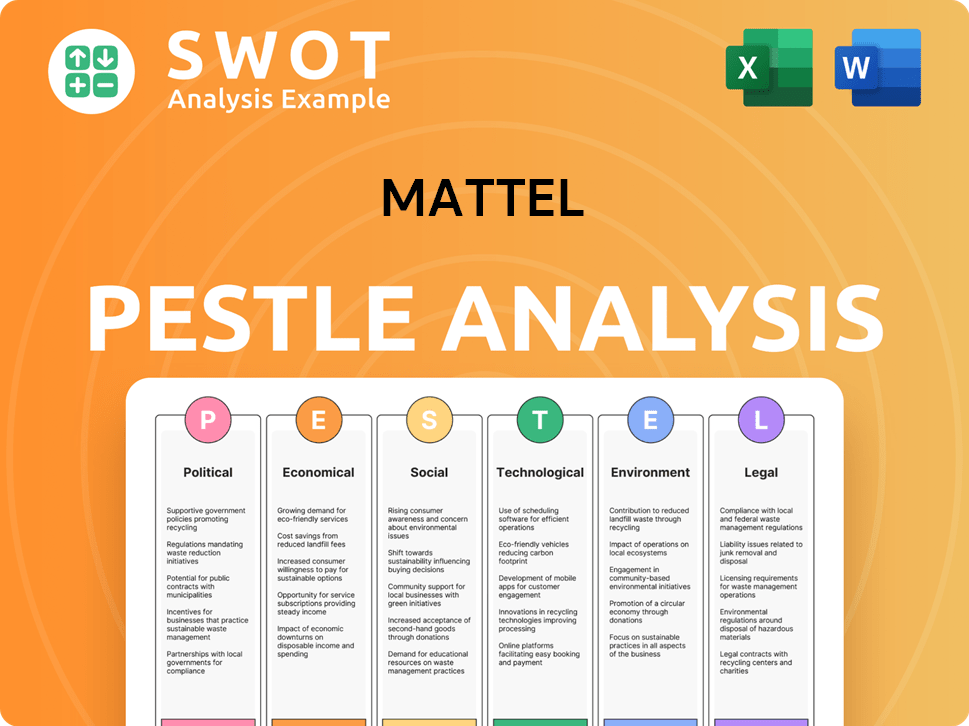
What Is Mattel’s Growth Forecast?
The financial outlook for Mattel reflects its strategic growth initiatives, with the company aiming for continued revenue growth and improved profitability. Recent reports indicate a positive trajectory, driven by strong performance from core brands and successful entertainment-led initiatives. This positive outlook is crucial for understanding the Mattel growth strategy.
Mattel's focus on optimizing its supply chain and managing costs is expected to contribute to healthy profit margins. The company continues to invest in its intellectual property, recognizing the long-term value of its iconic brands. Analyst forecasts generally anticipate steady growth, supported by diversified product offerings and expanding global reach. This positions the company well for its Mattel future prospects.
Mattel’s financial strategy also includes prudent capital allocation, balancing investments in growth opportunities with returning value to shareholders. This approach supports the company's long-term goals and overall Mattel company analysis.
Mattel reported a net sales increase of 1% in constant currency for the full year 2023 compared to the prior year. This growth demonstrates the effectiveness of the company's strategic initiatives and its ability to navigate toy industry trends.
Gross profit for the full year 2023 was $2.6 billion, or 47.5% of net sales, compared to $2.5 billion, or 46.3% of net sales, in 2022. This improvement in gross profit margin indicates successful cost management and pricing strategies.
Mattel's investments in its intellectual property and entertainment-led initiatives are key drivers of its long-term value creation. These investments support Mattel's strategy for online sales and expansion into new markets.
The company's diversified product offerings and expanding global reach are expected to support steady growth. This is crucial for understanding Mattel's revenue growth forecast and overall Mattel financial performance.
Mattel's financial strategy includes several key components that are essential for its continued success. These strategies are designed to ensure sustainable growth and enhance shareholder value.
- Prudent Capital Allocation: Balancing investments in growth opportunities with returning value to shareholders.
- Cost Management: Optimizing the supply chain and managing costs to improve profit margins.
- Intellectual Property Investment: Recognizing the long-term value of iconic brands and investing in their development.
- Diversification: Expanding product offerings and global reach to mitigate risks and capture new market opportunities.
Mattel Business Model Canvas
- Complete 9-Block Business Model Canvas
- Effortlessly Communicate Your Business Strategy
- Investor-Ready BMC Format
- 100% Editable and Customizable
- Clear and Structured Layout
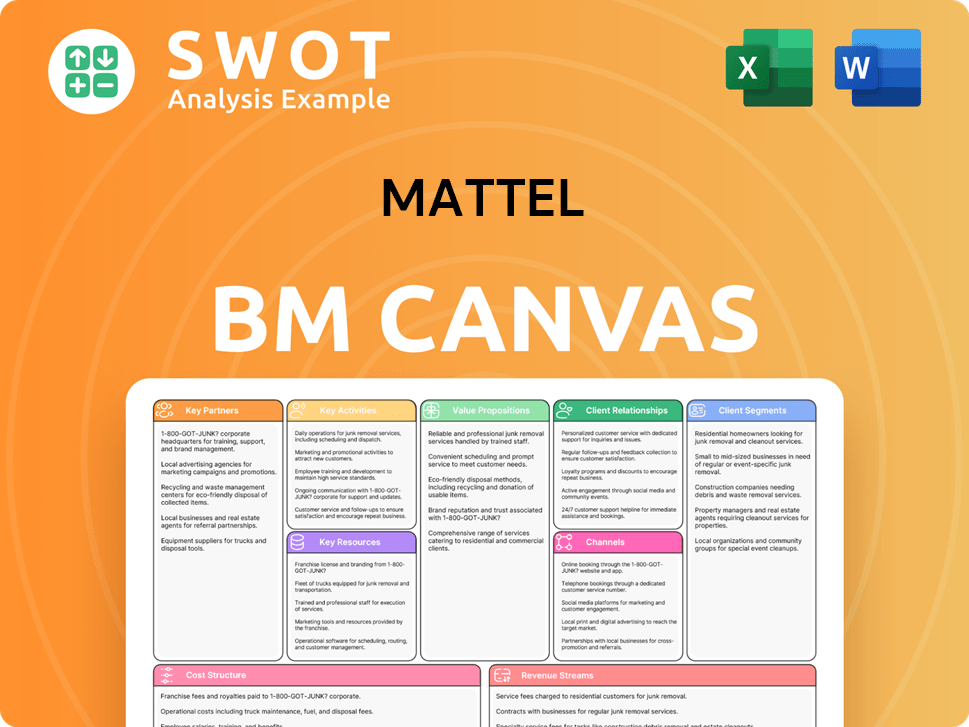
What Risks Could Slow Mattel’s Growth?
The toy industry is highly competitive, and the future prospects of the company are subject to various potential risks and obstacles. These challenges require constant innovation and effective marketing to maintain market share. Regulatory changes, supply chain issues, and technological disruptions can also significantly impact the company's operations and financial performance.
Adapting to evolving consumer preferences, especially the shift towards digital entertainment, is crucial for the company's success. Economic downturns and changing demographics can also affect consumer spending habits and sales. The company must proactively manage these risks through diversification, robust risk management, and strategic planning to ensure sustained growth.
The company faces a dynamic environment where it must navigate both established and emerging risks. This includes the increasing focus on data privacy for children's products and the rapid advancements in artificial intelligence. The company's ability to adapt to these challenges will be critical for its long-term success and maintaining its position in the toy industry.
The company faces fierce competition from established toy manufacturers and nimble startups. This competition necessitates continuous innovation in product design and marketing strategies. The ability to differentiate products and effectively reach consumers is crucial for maintaining and growing market share, as discussed in Competitors Landscape of Mattel.
Changes in regulations related to product safety, environmental standards, and data privacy can significantly impact the company. Compliance with these regulations can increase production costs and influence market entry strategies. The company must continuously monitor and adapt to evolving regulatory requirements to avoid penalties and maintain consumer trust.
Disruptions in the global supply chain can severely affect the production and distribution of toys. These disruptions can lead to increased costs, delays, and reduced availability of products. Diversifying suppliers and implementing robust supply chain management practices are essential to mitigate these risks, especially given recent global events.
The rapid advancement of technology and the shift towards digital entertainment pose a risk if the company fails to adapt. This includes the need to create interactive play experiences and integrate digital elements into traditional toys. Adapting to these trends requires significant investment in research and development and a focus on innovation.
Economic downturns and shifts in demographics can impact consumer spending on toys. Factors such as inflation, interest rates, and consumer confidence influence purchasing decisions. The company must monitor these trends and adjust its product offerings and pricing strategies to remain competitive and meet consumer demand.
The increasing scrutiny on data privacy for children's products and the rapid development of AI present both opportunities and challenges. The company must ensure compliance with data privacy regulations and explore how AI can enhance product development and consumer experiences. This requires careful consideration of ethical and legal implications.
The company mitigates these risks through diversification of its product portfolio, robust risk management frameworks, and proactive scenario planning. Diversifying its product offerings helps to spread risk across different toy categories and consumer segments. Strong risk management frameworks are essential for identifying, assessing, and mitigating potential threats.
The company is adapting to digital trends by integrating digital elements into its toys and expanding its online presence. This includes developing interactive play experiences, creating digital content, and strengthening its e-commerce capabilities. These efforts are crucial for reaching younger consumers and staying relevant in a rapidly evolving market.
Mattel Porter's Five Forces Analysis
- Covers All 5 Competitive Forces in Detail
- Structured for Consultants, Students, and Founders
- 100% Editable in Microsoft Word & Excel
- Instant Digital Download – Use Immediately
- Compatible with Mac & PC – Fully Unlocked
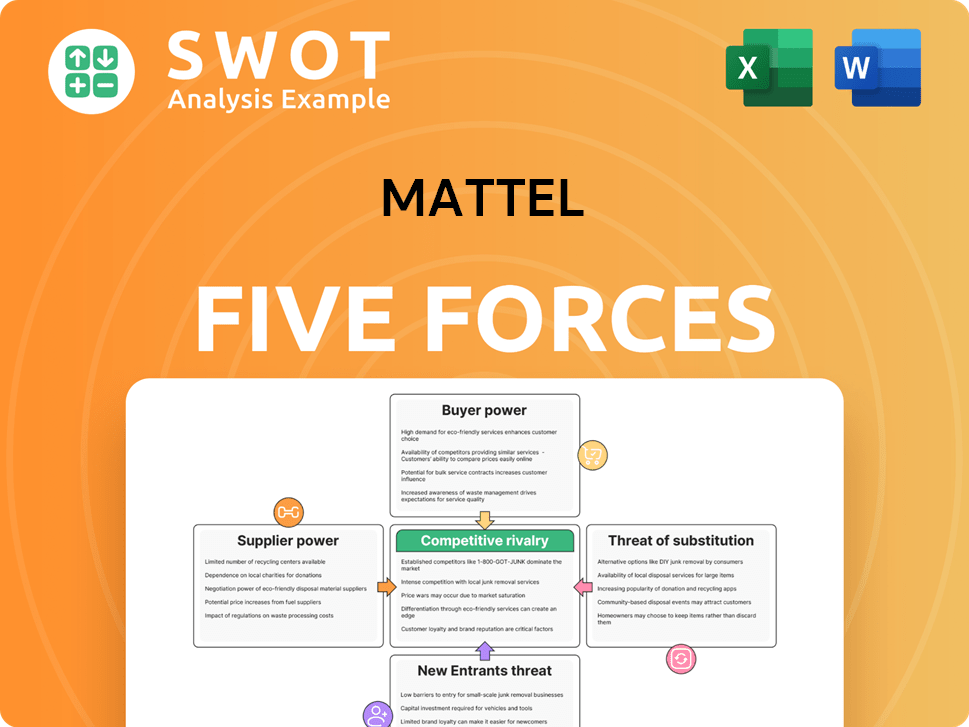
Related Blogs
- What are Mission Vision & Core Values of Mattel Company?
- What is Competitive Landscape of Mattel Company?
- How Does Mattel Company Work?
- What is Sales and Marketing Strategy of Mattel Company?
- What is Brief History of Mattel Company?
- Who Owns Mattel Company?
- What is Customer Demographics and Target Market of Mattel Company?
Disclaimer
All information, articles, and product details provided on this website are for general informational and educational purposes only. We do not claim any ownership over, nor do we intend to infringe upon, any trademarks, copyrights, logos, brand names, or other intellectual property mentioned or depicted on this site. Such intellectual property remains the property of its respective owners, and any references here are made solely for identification or informational purposes, without implying any affiliation, endorsement, or partnership.
We make no representations or warranties, express or implied, regarding the accuracy, completeness, or suitability of any content or products presented. Nothing on this website should be construed as legal, tax, investment, financial, medical, or other professional advice. In addition, no part of this site—including articles or product references—constitutes a solicitation, recommendation, endorsement, advertisement, or offer to buy or sell any securities, franchises, or other financial instruments, particularly in jurisdictions where such activity would be unlawful.
All content is of a general nature and may not address the specific circumstances of any individual or entity. It is not a substitute for professional advice or services. Any actions you take based on the information provided here are strictly at your own risk. You accept full responsibility for any decisions or outcomes arising from your use of this website and agree to release us from any liability in connection with your use of, or reliance upon, the content or products found herein.